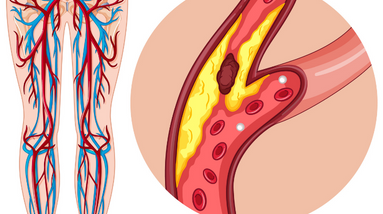
Peripheral artery disease (PAD) is a condition in which the arteries in the legs and feet become narrowed or blocked, reducing blood flow to these areas. This can cause symptoms such as pain, cramping, and fatigue in the legs during activity (claudication), as well as poor wound healing and an increased risk of infection.
PAD is most commonly caused by atherosclerosis, which is a buildup of plaque in the inner lining of the artery wall. Other risk factors for PAD include smoking, diabetes, high blood pressure, high cholesterol, and a family history of the condition.
Treatment for PAD may include lifestyle changes such as quitting smoking, eating a healthy diet, and exercising regularly. Medications such as blood thinners, cholesterol-lowering drugs, and medications to improve blood flow may also be prescribed. In some cases, a procedure called angioplasty may be recommended to open up the blocked or narrowed arteries and improve blood flow.
It’s important to seek medical attention if you have any symptoms of PAD or if you have risk factors for the condition. Early detection and treatment can help reduce the risk of complications and improve quality of life.